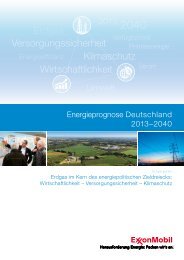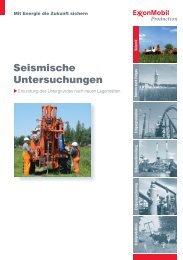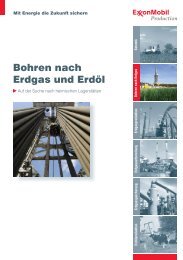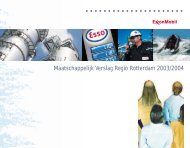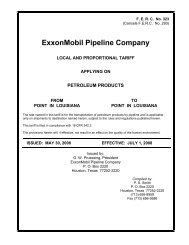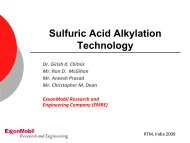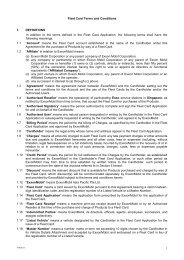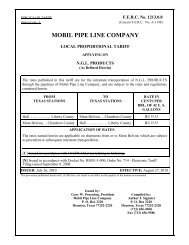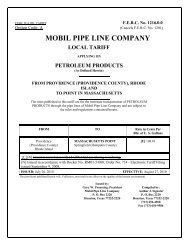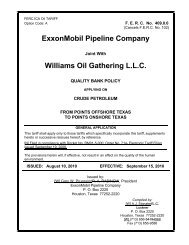BenzOUT Reducing Benzene Enhancing Gasoline ... - ExxonMobil
BenzOUT Reducing Benzene Enhancing Gasoline ... - ExxonMobil
BenzOUT Reducing Benzene Enhancing Gasoline ... - ExxonMobil
Create successful ePaper yourself
Turn your PDF publications into a flip-book with our unique Google optimized e-Paper software.
<strong>BenzOUT</strong> <br />
<strong>Reducing</strong> <strong>Benzene</strong><br />
<strong>Enhancing</strong> <strong>Gasoline</strong> Product<br />
Value<br />
Dr. El-Mekki El-Malki<br />
Dr. Michael Clark<br />
Page 1<br />
NPRA Conference<br />
Phoenix, AZ<br />
March 21 - 23, 2010
<strong>Reducing</strong> <strong>Benzene</strong> in <strong>Gasoline</strong> Pool<br />
1 vol%<br />
Legislation pending<br />
1 to 0.62 vol%<br />
by 2011<br />
1-2.5vol %<br />
range<br />
1 vol %<br />
Page 2<br />
1.5-4 vol %<br />
range<br />
1-5 vol %<br />
range<br />
1 vol %
Typical <strong>Gasoline</strong> Pool <strong>Benzene</strong> in US<br />
Components Average Volume<br />
in <strong>Gasoline</strong> %<br />
Page 3<br />
Typical <strong>Benzene</strong><br />
Level %<br />
<strong>Benzene</strong><br />
Contribution %<br />
Reformate ~ 30 3-11 11 ~ 75<br />
FCC <strong>Gasoline</strong> ~36 0.5-2 ~16<br />
Hydrocrackate ~3 1-5 ~3<br />
Others ~31 0-3 ~6<br />
Reference: EPA-HQ-OAR-2005-0036; FRL-8041-2, Table VII.F-2
Refiner’s Options<br />
Reformer Feed<br />
Tailoring<br />
<strong>Benzene</strong><br />
Extraction<br />
<strong>Benzene</strong><br />
Saturation<br />
<strong>Gasoline</strong><br />
Volume<br />
Octane<br />
<strong>Gasoline</strong><br />
Pool<br />
Page 4<br />
Hydrogen<br />
Balance<br />
Light<br />
Olefin<br />
Less H 2<br />
produced -<br />
No<br />
change -<br />
High H 2<br />
consumption<br />
<strong>BenzOUT</strong> No H 2<br />
consumption<br />
-<br />
Upgrade to<br />
Mogas
Simplified <strong>BenzOUT</strong> Process<br />
Configuration<br />
Full Reformate<br />
<strong>Benzene</strong><br />
Concentrate<br />
Splitter <strong>BenzOUT</strong><br />
Reactor<br />
• Fixed Bed Reactor Configuration<br />
Adiabatic or Isothermal<br />
Carbon steel equipment and no compressor needed<br />
• Process Uses a Proprietary Catalyst<br />
High activity, High selectivity and a Long catalyst life<br />
• Typical Olefin Feed Pretreatment<br />
Page 5<br />
Pretreatment<br />
Light Olefins<br />
Light end<br />
Splitter<br />
Products
<strong>BenzOUT</strong> – <strong>Reducing</strong> <strong>Benzene</strong> while<br />
Boosting Product Value<br />
• <strong>BenzOUT</strong> Process Alkylates <strong>Benzene</strong>-Containing Streams with<br />
Light Olefins to Produce Alkyl Aromatics for <strong>Gasoline</strong> Blending<br />
• Incentives Include:<br />
<strong>Reducing</strong> <strong>Benzene</strong> to meet regulations<br />
Upgrading Light Olefins to high octane gasoline<br />
Increasing <strong>Gasoline</strong> volume and reducing RVP<br />
Commercially demonstrated<br />
Avoid the need for H 2 associated with alternative solutions<br />
Provide the flexibility to retain H 2 production by allowing refineries to feed the C6’s to<br />
the reformer<br />
Page 6
<strong>Benzene</strong> Conversion Can Be Achieved<br />
According to Need<br />
<strong>Benzene</strong> Conversion (%)<br />
100<br />
0<br />
Olefin/Aromatic Ratio<br />
• Primary Reaction Chemistry is Alkylation of <strong>Benzene</strong> with Olefin<br />
<strong>Benzene</strong> conversion controlled by Olefin/Aromatic ratio<br />
Approx. (R+M)/2 increase of 2-5, depending on the feed composition<br />
Page 7
Example of <strong>BenzOUT</strong> Boosting<br />
Product Volume<br />
40 KB/D<br />
Full Reformate<br />
<strong>Benzene</strong><br />
Concentrate<br />
Splitter<br />
Page 8<br />
Pretreatment<br />
Light Olefin<br />
Light end<br />
Splitter<br />
42.3 KB/D
Example of <strong>BenzOUT</strong> Product<br />
Boiling Range<br />
Temperature ( o F)<br />
Typical <strong>Gasoline</strong> End Point<br />
% Evaporated<br />
• Final Product BP is a Function of Feed Composition and <strong>Benzene</strong> Conversion<br />
• Process & Catalyst are Optimized to Minimize Heavies<br />
<strong>BenzOUT</strong> Products Contribution to Total Mogas Pool is Small<br />
Page 9<br />
Product<br />
Feed
Process Demonstrated in a<br />
North America Refinery<br />
• <strong>BenzOUT</strong> Catalyst Drop-in Application<br />
Only minor modification to the Polygas Unit<br />
• <strong>BenzOUT</strong> Demonstration Conducted in One of the 3 Tubular Reactors<br />
• <strong>BenzOUT</strong> and Polygas Products Combined for Mogas Blending<br />
Page 10<br />
Light Olefin<br />
Reformate<br />
<strong>BenzOUT</strong><br />
Catalyst<br />
Mogas Blending
Commercial Trial Results Confirmed<br />
Pilot Plant Results<br />
<strong>Benzene</strong> Conversion (%)<br />
100<br />
0<br />
0 10 20 30<br />
Days on Stream<br />
40 50 60<br />
• High <strong>Benzene</strong> Conversion Demonstrated<br />
• Commercial Data Confirms Projection based on Pilot Plant Data<br />
Page 11<br />
Olefin/Aromatic ratio
Application Scenarios<br />
• Existing PolyGas Reactors or Other Fixed Bed Reactors<br />
(Reformers, C5/C6 Isomerization units) Can Be Retrofitted<br />
for This Application<br />
• Grassroots Design Available<br />
Page 12
<strong>BenzOUT</strong> Technology Delivery to 3rd<br />
Party Customers<br />
• <strong>ExxonMobil</strong> Research & Engineering Company (EMRE) and<br />
Badger Licensing LLC formed an Alliance to License <strong>BenzOUT</strong><br />
Technology<br />
<strong>BenzOUT</strong> offered exclusively by Badger Licensing LLC<br />
Badger will be the contracting party responsible for the process license,<br />
proposals and basic design packages.<br />
EMRE will supply the <strong>BenzOUT</strong> Catalyst<br />
• <strong>ExxonMobil</strong> and Badger have a continuing 30 year history of<br />
licensing Petrochemical processes<br />
Page 13
<strong>BenzOUT</strong> Advantages - Summary<br />
Reduction of <strong>Benzene</strong> Content in the <strong>Gasoline</strong> Pool via Conversion to<br />
Alkylaromatics<br />
Upgrading Light Olefins and <strong>Benzene</strong> (Toluene) to High Octane <strong>Gasoline</strong><br />
Blendstock<br />
Avoid the need for H 2<br />
Upgrading Product Value<br />
Swell in Total <strong>Gasoline</strong> Volume<br />
Increase Octane<br />
Reduce RVP<br />
Providing the flexibility for Increasing C 6 Feed to Reformer for increased<br />
H 2 production<br />
Page 14




